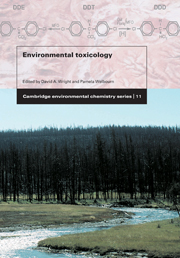Book contents
- Frontmatter
- Contents
- Foreword
- Preface
- Abbreviations
- Acknowledgements
- 1 The emergence of environmental toxicology as science
- 2 The science of environmental toxicology: Concepts and definitions
- 3 Routes and kinetics of toxicant uptake
- 4 Methodological approaches
- 5 Factors affecting toxicity
- 6 Metals and other inorganic chemicals
- 7 Organic compounds
- 8 Ionising radiation
- 9 Complex issues
- 10 Risk assessment
- 11 Recovery, rehabilitation, and reclamation
- 12 Regulatory toxicology
- 13 An overall perspective, or where to from here?
- Glossary
- Index
Foreword
Published online by Cambridge University Press: 05 June 2012
- Frontmatter
- Contents
- Foreword
- Preface
- Abbreviations
- Acknowledgements
- 1 The emergence of environmental toxicology as science
- 2 The science of environmental toxicology: Concepts and definitions
- 3 Routes and kinetics of toxicant uptake
- 4 Methodological approaches
- 5 Factors affecting toxicity
- 6 Metals and other inorganic chemicals
- 7 Organic compounds
- 8 Ionising radiation
- 9 Complex issues
- 10 Risk assessment
- 11 Recovery, rehabilitation, and reclamation
- 12 Regulatory toxicology
- 13 An overall perspective, or where to from here?
- Glossary
- Index
Summary
Environmental Toxicology is a welcome addition to the Cambridge University Press Environmental Chemistry Series. The inclusion of a textbook on toxicology in a series devoted to environmental chemistry might, at first glance, appear surprising. However, as will become evident to the reader, the authors have approached their topic in a truly interdisciplinary manner, with environmental chemistry playing a prominent role in their analysis.
Environmental toxicology is a young and dynamic science, as pointed out by the authors in their welcome historical perspective of its development over the past 30+ years. One of the inevitable consequences of the rapid evolution of this area of science has been the scarcity of useful textbooks. Several multiauthored books have appeared in recent years, usually consisting of specialised chapters written by researchers familiar with a specific area of environmental toxicology. The individual chapters in such volumes are often very useful as state-of-the-art reviews, but links between and among chapters are difficult to establish. Environmental Toxicology breaks with this trend and offers a broad and coherent vision of the field, as developed by two senior researchers who have been active in this area of research since its inception in the 1970s.
In keeping with the aims of the Environmental Chemistry Series, this book is designed for use in courses offered to senior undergraduates and to graduate students. As university professors, the authors have used much of the material in their own courses, and thus, in a certain sense, the overall approach has already been tested and refined in the classroom.
- Type
- Chapter
- Information
- Environmental Toxicology , pp. xvii - xviiiPublisher: Cambridge University PressPrint publication year: 2002



